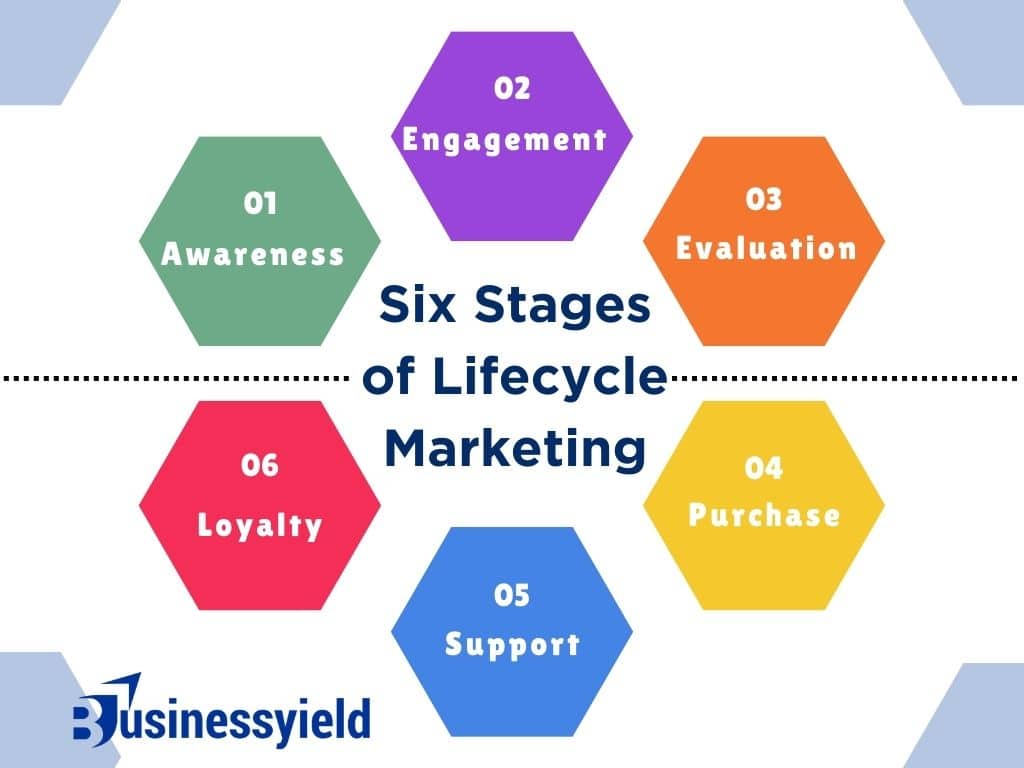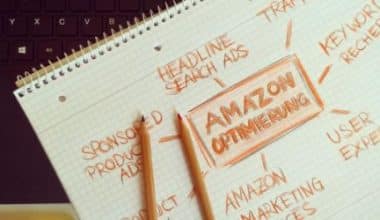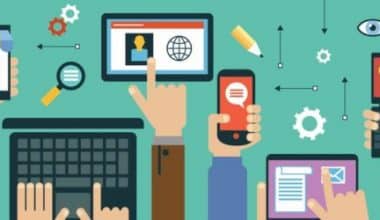Lifecycle marketing is more than just a cliché in the digital marketing world; it is a revolutionary strategy that changes how we interact with customers. It allows you to maximize your efforts to attract and convert customers, boost customer lifetime value by reselling to them, and generate recommendations to help your business expand.
In this piece, we’ll go over the stages of lifecycle marketing and how to utilize them in your organization.
What is Lifecycle Marketing?
Lifecycle marketing refers to the entire set of marketing methods that a customer encounters while interacting with your marketing funnel. It uses the power of customer contact to gain a better grasp of their psychology, motivations, and worries, as well as the unique solutions your products or services provide them. Then it applies this data to create solutions that allow you to influence their purchasing decisions.
Lifecycle marketing begins with advertising and brand development to help your company stand out in your sector, and it continues long after a customer makes their initial purchase. The ultimate goal of lifecycle marketing is to establish a network of committed supporters who will become long-term customers. Furthermore, lifecycle marketing plans cover almost any marketing approach you can think of, including:
- Online marketing, including pay-per-click advertising, content marketing, and your company’s website and social media profiles
- Direct-to-consumer strategies include lifecycle email marketing, text message marketing, and direct mail initiatives.
- Customer support, community forums, loyalty programs, and many other programs that give value to consumers
- Promotional events include sweepstakes, free trials, and special discount offers.
Overall, lifecycle marketing is a strategy that makes use of each stage of the marketing cycle to deliver user-specific marketing messages.
For example, potential customers who are new to your brand require information that demonstrates why your product is more valuable than your competitors. Similarly, customers further along in their journey require a message that validates their decision to choose your brand. Customer service and loyalty incentive programs are helpful in this situation. They ensure that your customers receive long-term value in addition to the quality of your products and services.
Read Also: LOYALTY PROGRAM: Definition, Purposes, and How It Works
Consumer lifecycles can be long or short, depending on how frequently customers require your product or service. This is an important component to consider while developing your lifecycle marketing plan.
Examples of businesses with brief lifecycles include:
- Clothing Boutiques
- Toy retailers.
- Electronic manufacturers
These businesses have short lifecycles because fashion changes with the seasons, youngsters outgrow their games and gadgets, and tech developers are continuously offering new items with unique capabilities.
However, if you sell furniture or autos, you should expect a longer lifecycle. Consumers tend to keep these items for a longer period before repurchasing them.
Benefits of the Lifecycle Marketing Model
At its foundation, lifecycle marketing is a straightforward method for gathering valuable data that exposes important insights about your customers and their purchasing habits. You may then translate those findings into practical plans for creating a simple, engaging, and personalized customer experience, regardless of where a consumer is in their marketing journey.
The lifecycle marketing model’s only goal is to build a foundation of stable, loyal customers, and one of the most crucial components is creating a customer-centric experience. This begins with providing high-quality products and excellent customer service, but it does not stop there.
Modern e-commerce customers have high expectations of the businesses they purchase from. These include simple purchasing options, dependable websites, and programs that reward customers for choosing your brand.
Read Also: REWARD PROGRAMS: Best, Credit Card, Hotel, Airline & Gas Loyalty Programs
Once you’ve used lifecycle marketing to fine-tune the experience you offer, you’ll be on your way to realizing the full potential of the lifecycle marketing model. These benefits include:
- You get more value out of customers during their lifetime: Loyal customers contribute significantly to your company’s success, spending up to 67% more than those who make only one or two purchases. One reason for this is that regular contacts with customers allow you to gain their trust, which can lead to them purchasing more of your products or shopping at higher prices.
- You save time and increase earnings: Attracting new customers is more difficult and costs firms around five times more than retaining existing customers. Plus, focusing on repeat customers can increase your profitability by up to 75% on average.
- You improve your marketing efforts: Lifecycle marketing is based on data-driven insights that allow you to create more effective marketing campaigns. Understanding consumer behavior allows you to create customer lifecycle marketing that is tailored to your customer’s needs, which increases customer engagement. Consumers who are engaged spend up to 23% more with you than with your competitors, compared to those who are less engaged.
- Your customers feel valued: Today, consumers want more than just brands that address their specific requirements and situations; up to 66% of consumers expect companies to reach out to them with tailored marketing messages.
- You get a competitive advantage: Lifecycle marketing helps to improve customer service, create better customer experiences, and run more successful marketing campaigns, giving you more control over customer behavior. This allows you to stand out in the marketplace.

Stages of Lifecycle Marketing
- Awareness
- Engagement
- Evaluation
- Purchase
- Support
- Loyalty
Here’s a quick outline of the major lifecycle stages:
#1. Awareness
This is when prospective customers first discover your company. As the top of your conversion funnel, this is your opportunity to capture people’s attention and draw them deeper into your funnel.
#2. Engagement
People start interacting with your brand during the engagement period. They are intrigued and want to learn more about your offerings, whether they subscribe to your email list, follow you on social media, or browse your website.
#3. Evaluation
Decision-making is crucial to the evaluation step. This is the moment to make it simple for customers to select your brand by providing them with the necessary information to compare features, pricing, and value.
#4. Purchase
Anyone who gets through this stage is a customer. I utilize this stage not to promote my business but to make a purchase as simple as possible, making it easy for people to click “Buy.”
#5. Support
People, in my experience, tend to drop off after the first transaction, which is why it’s critical to address customers’ demands following the sale. During the support stage, your job is to follow up with customers to ensure they are satisfied with their purchase.
#6. Loyalty
Customers reach this stage when they are so pleased with your product that they spread the word about it. You want to cultivate such advocacy to keep their business and attract new customers.
My experience with lifecycle stages has taught me that, while it appears to be a linear buyer journey in which customers progress from step to step until they reach the finish, it is a cycle that should continue to repeat itself.
In other words, you cannot simply forget about a customer after they have completed a transaction. If you put in the work to create a strategic plan, it will be much easier to reach and surpass your marketing, sales, and company objectives.
Best Practices for Optimizing Customer Lifecycle Marketing
Now that you understand the complete concept of lifecycle marketing and what it can do to increase brand loyalty among your customers, you must be eager to create a plan from scratch or redesign your present model. To help you get started, here are five lifecycle marketing concepts that will increase customer retention and earnings.
#1. Buyer personas can help you gain a better understanding of your target audience.
Buyer personas, also known as customer avatars, are fictitious representations of your ideal customers that enable you to better understand their psychology, including their thoughts, feelings, concerns, expectations, and beliefs. In a nutshell, they are a type of role-playing that allows you to leverage information from customer purchases to generate marketing concepts that work for your company.
These personas include descriptions that correspond to specific sectors of your target audience and are smartly titled to convey the consumer type they represent. Buyer personas may differ by business, but it’s useful to conceive of them in terms of a few traditional archetypes, such as:
- The Bargain Hunter
- The Brand Loyalist
- The Impulse Buyer
- The innovator
- The Value Shopper
It is critical to consult a range of sources to gather the consumer data required to create personas that accurately represent your customers. The data should include the following:
- Demographics and Psychographics
- Their shopping habits, including where they spend (e.g., online, in-store, etc.) and how frequently
- The solutions your brand offers
- Their preferred way to get marketing communications
- The elements that may cause them to hesitate before purchasing.
#2. Set goals for every step.
When developing your lifecycle marketing strategy, make sure to identify specific goals for each of the cycle’s six stages. Yes, your overall goal is customer retention. However, by breaking down the project into smaller, more specific goals, you will be able to better track your performance based on the indicators that are most important to your brand.
#3. Segment customers based on milestones.
When I was leading an e-commerce company, one of my first objectives was to redesign our email marketing approach. We started by segmenting our customers based on their engagement history. This segmentation enabled us to create targeted messaging for various groups, ranging from first-time visitors to long-time customers.
This method had a significant impact: we saw a 40% increase in email engagement, indicating that our messages were more successfully reaching our target demographic. To achieve this level of customization, it is useful to categorize customers based on flash points particular to their trip. For example, you might give promotional discounts or awards for milestones like:
- First-time purchases.
- Repeat purchases.
- Loyalty anniversary
#3. Identify and resolve friction
Keep an eye out for friction points in each stage that compromise the quality of the customer experience. Is the appearance or functionality of your website difficult to use? Are you making it easy for potential customers to access information that will persuade them to purchase your product? Are there any communication gaps or service discrepancies in the post-purchase stages that may prevent customers from returning?
Creating a customer journey map is one of the most effective lifecycle marketing strategies for identifying friction points in your plan. Customer journey maps allow you to visualize how customers go through the cycle, particularly at key stages such as:
- Discovery
- Purchase
- After-purchase use
Once you’ve identified these pain spots, you and your team can explore remedies. In this manner, once your plan is up and running, you can readily identify and resolve difficulties that appear trivial but, in reality, serve as a deterrent to gaining loyal customers.
#4. Timing is everything
Another crucial lesson was the value of time. We carefully considered the optimal times to send emails, post on social media, and launch new items. Understanding the customer’s schedule and preferences increased the likelihood that our communications would be received and acted upon. This technique worked notably well in our ‘Abandoned Cart’ campaign, as timely reminders resulted in a large recovery of possibly lost revenue.
#5. Use marketing automation tools
Automating marketing duties at all stages of the marketing cycle is an excellent technique to improve productivity while maintaining the personalized outreach that customers demand. Some easy-to-automate lifecycle marketing strategies include advertising, email marketing, and social media marketing.
We used a variety of marketing tools and technologies to implement our lifecycle marketing plans. Automation was particularly useful in managing routine communications and ensuring timely follow-ups. However, we blended automation with a personal touch to keep our messaging honest and relatable.
Lifecycle Marketing vs Sales Funnel
Fundamentally, these are two opposing approaches to doing business and selling products, and the key distinction is the attitude toward people.
A sales funnel refers to the use of marketing methods to sell as many products as possible, as quickly as feasible. It may fall under the category of supplying people with what they require, but it is mostly concerned with convincing users that they require something and then selling it.
Lifecycle marketing, on the other hand, is a more humanitarian approach to a company that aims to assist the target audience in resolving their issues. It allows you to create the buyer journey you want to have. Such an attitude leads to mutually fruitful and respectful partnerships.
In practice, the distinctions between these phrases may blur because each marketing strategy is at least somewhat convincing to attract traffic and win over competition. At the same time, forceful sales are an obsolete model because users now have more control over their connection with brands and can opt out at any time.
Both techniques work but in different ways. Choosing one is an ethical question.
The Impact of AI and Machine Learning on Lifecycle Marketing
AI and machine learning are poised to transform lifecycle marketing by providing new insights into customer behavior. The predictive capability of these technologies enables the examination of massive data sets, discovering patterns and trends that the human eye may overlook. This means we can better predict customer demands, preferences, and potential churn concerns, resulting in more targeted, timely, and successful marketing actions.
Personalization on a New Level
The future of lifecycle marketing will see personalization rise to unprecedented heights. AI-driven analytics will allow us to create hyper-personalized experiences based on individual customer preferences, behaviors, and purchase histories. This level of customization will extend beyond email communication to include all touchpoints along the customer journey, resulting in a seamless, highly personalized experience.
Predictive Analytics: Forecasting Customers’ Journeys
Predictive analytics will become a cornerstone of lifecycle marketing. Marketers will be able to forecast customers’ future actions based on their past habits if they use AI. This foresight will enable proactive engagement methods, ensuring that marketing activities remain one step ahead of the customer’s needs.
Agility in Adaptation: The New Marketing Mantra
In this continuously changing context, agility will be essential. Marketers must be agile, always responding to new technological breakthroughs and shifting customer dynamics. This includes remaining current on AI and machine learning trends, constantly trying new tools and tactics, and being prepared to pivot approaches at a moment’s notice.
The Ethical Aspect of AI in Marketing
As we integrate AI deeper into lifecycle marketing, ethical concerns will become more critical. Data privacy, consent, and transparency will be top priorities. Marketers will need to handle these problems carefully, ensuring that customer data is used safely and ethically while still leveraging AI for effective marketing.
Integrating AI and Human Insight
Despite the rise of AI, the human element will remain important. The future of lifecycle marketing will feature a mutually beneficial link between AI-driven insights and human creativity and empathy. While AI delivers data and forecasts, the human touch will be required to create captivating storylines and emotionally engaging marketing campaigns.
Continuous Learning
For marketers, the future consists of continuous learning and adaptation. Staying on top of developing technologies, recognizing the implications of AI in marketing, and consistently upskilling will be critical to success. Marketers who accept change, experiment on a regular basis, and use AI to enrich and improve the customer lifecycle experience will succeed.
Looking ahead, the trajectory of lifecycle marketing is clear: it will become more intelligent, predictive, and personalized. As AI and machine intelligence become more fundamental parts of marketing campaigns, the opportunities for engaging customers in meaningful and impactful ways expand. For marketers, the future is more than just responding to change; it is about leading it, with a close eye on technology and a firm dedication to the human touch, which is at the heart of all marketing efforts.
Conclusion
My experiences with lifecycle marketing have been both tough and gratifying. It’s taught me the value of truly researching your audience and connecting with them in a way that is relevant to their interaction with your company. Those embarking on this road should keep in mind that the ability to evolve with your customers is critical to lifecycle marketing success.
I’d like to know about your experiences or issues with lifecycle marketing. Feel free to leave your stories or questions in the comments section. Let’s study and grow together in an ever-changing marketing environment.
- PRODUCT DEVELOPMENT LIFECYCLE: Definition, Process & Stages
- ASSET MANAGEMENT SYSTEM: Benefits & Top 5 Software Solutions
- Project Lifecycle: Meaning, Stages & Why It’s Important
- Customer Lifecycle: Definition & All You Should Know






